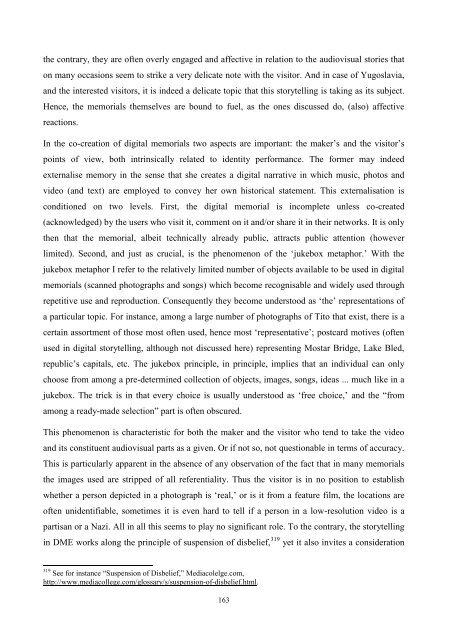UNIVERSITY OF NOVA GORICA GRADUATE SCHOOL ...
UNIVERSITY OF NOVA GORICA GRADUATE SCHOOL ...
UNIVERSITY OF NOVA GORICA GRADUATE SCHOOL ...
You also want an ePaper? Increase the reach of your titles
YUMPU automatically turns print PDFs into web optimized ePapers that Google loves.
the contrary, they are often overly engaged and affective in relation to the audiovisual stories that<br />
on many occasions seem to strike a very delicate note with the visitor. And in case of Yugoslavia,<br />
and the interested visitors, it is indeed a delicate topic that this storytelling is taking as its subject.<br />
Hence, the memorials themselves are bound to fuel, as the ones discussed do, (also) affective<br />
reactions.<br />
In the co-creation of digital memorials two aspects are important: the maker‘s and the visitor‘s<br />
points of view, both intrinsically related to identity performance. The former may indeed<br />
externalise memory in the sense that she creates a digital narrative in which music, photos and<br />
video (and text) are employed to convey her own historical statement. This externalisation is<br />
conditioned on two levels. First, the digital memorial is incomplete unless co-created<br />
(acknowledged) by the users who visit it, comment on it and/or share it in their networks. It is only<br />
then that the memorial, albeit technically already public, attracts public attention (however<br />
limited). Second, and just as crucial, is the phenomenon of the ‗jukebox metaphor.‘ With the<br />
jukebox metaphor I refer to the relatively limited number of objects available to be used in digital<br />
memorials (scanned photographs and songs) which become recognisable and widely used through<br />
repetitive use and reproduction. Consequently they become understood as ‗the‘ representations of<br />
a particular topic. For instance, among a large number of photographs of Tito that exist, there is a<br />
certain assortment of those most often used, hence most ‗representative‘; postcard motives (often<br />
used in digital storytelling, although not discussed here) representing Mostar Bridge, Lake Bled,<br />
republic‘s capitals, etc. The jukebox principle, in principle, implies that an individual can only<br />
choose from among a pre-determined collection of objects, images, songs, ideas ... much like in a<br />
jukebox. The trick is in that every choice is usually understood as ‗free choice,‘ and the ―from<br />
among a ready-made selection‖ part is often obscured.<br />
This phenomenon is characteristic for both the maker and the visitor who tend to take the video<br />
and its constituent audiovisual parts as a given. Or if not so, not questionable in terms of accuracy.<br />
This is particularly apparent in the absence of any observation of the fact that in many memorials<br />
the images used are stripped of all referentiality. Thus the visitor is in no position to establish<br />
whether a person depicted in a photograph is ‗real,‘ or is it from a feature film, the locations are<br />
often unidentifiable, sometimes it is even hard to tell if a person in a low-resolution video is a<br />
partisan or a Nazi. All in all this seems to play no significant role. To the contrary, the storytelling<br />
in DME works along the principle of suspension of disbelief, 319 yet it also invites a consideration<br />
319 See for instance ―Suspension of Disbelief,‖ Mediacolelge.com,<br />
http://www.mediacollege.com/glossary/s/suspension-of-disbelief.html.<br />
163

















